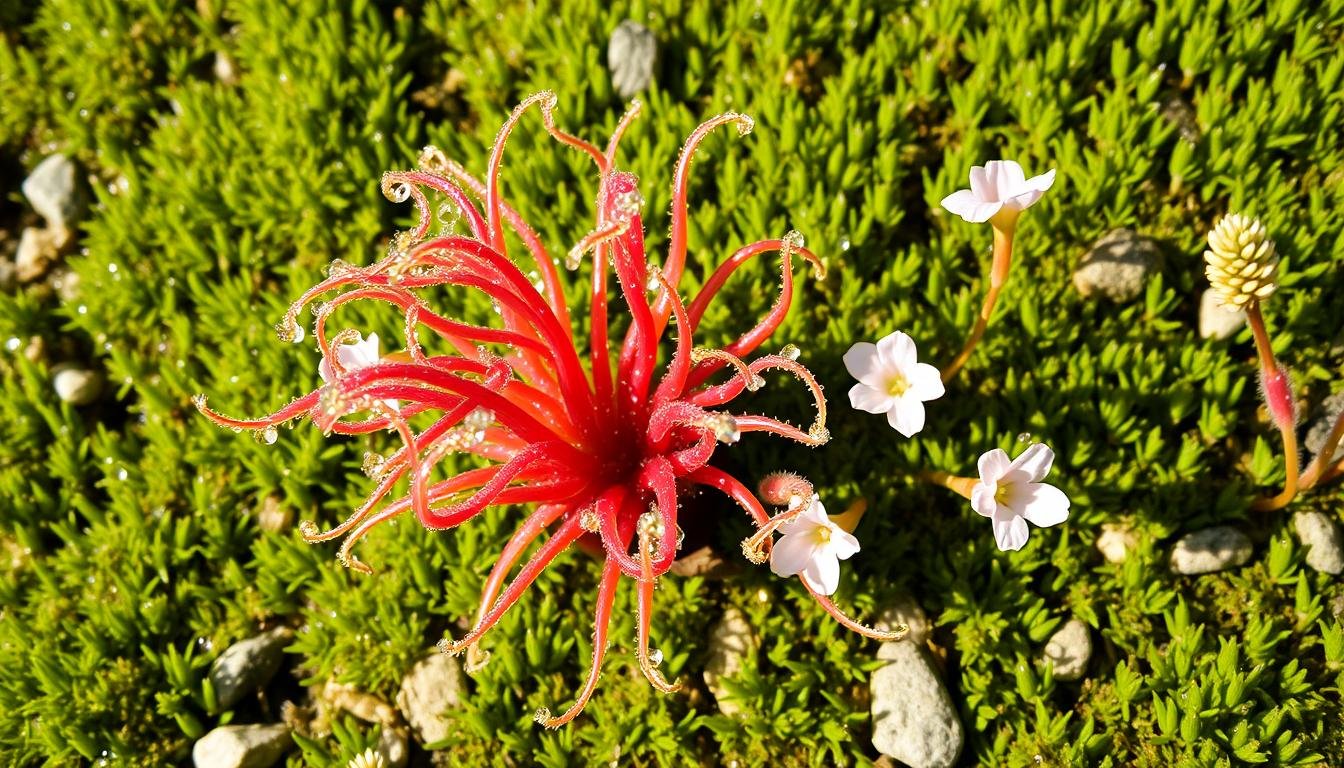Welcome to the world of sundew plants, a fascinating group of carnivorous plants. They have sticky, dew-tipped leaves that catch insects. These plants, from the genus Drosera, are surprisingly easy to grow. They’re perfect for beginners and plant collectors.
In this guide, you’ll learn how to care for these enchanting plants. You’ll discover their unique growing needs and different sundew species. We’ll cover the best soil, watering, and feeding tips to keep them healthy. Plus, we’ll explore how to propagate them, making it easy to grow more.
Key Takeaways
- Sundews grow in sunny, wet, and sandy peat soil.
- There are nearly 200 species of sundews worldwide.
- Sundews can be easily propagated through leaf cuttings and root sections.
- Most sundews thrive in alliances with Sphagnum moss in their natural habitats.
- Feeding once or twice a month is typically sufficient for sundew plants.
- Tropical sundews do not go dormant and flourish year-round.
Introduction to Sundew Plants
Sundew plants are a fascinating group of carnivorous wonders in the plant world. They come in over 250 different species. These plants love wet and boggy places and can be found on every continent except Antarctica.
They have special glandular tentacles that help them catch and eat insects. The dew on their leaves looks beautiful and attracts insects. When an insect touches the leaves, the tentacles move in to trap it, making sure the sundew gets its meal.
There are many sundew species, from the small pygmy sundews in Australia to the huge Drosera gigantea. Their variety and unique features make them some of the most captivating carnivorous plants in nature.
What Are Sundew Plants?
Sundew plants, known as Drosera, are a big group of carnivorous plants with over 194 species. They live in places where food is hard to find. Sundews have special ways to catch and eat insects to get the nutrients they need.
These plants have sticky tentacles that trap insects. When an insect touches, the tentacles snap shut. This is how sundews get their food. Charles Darwin studied Drosera rotundifolia to learn about their eating habits.
Sundews can be found on every continent except Antarctica. They grow in different ways and have leaves that fit their homes. This shows how well they adapt to their surroundings.
Sundews can live up to 50 years. This shows how tough they are. Scientists are learning more about how sundews move and grow, helping us understand them better.
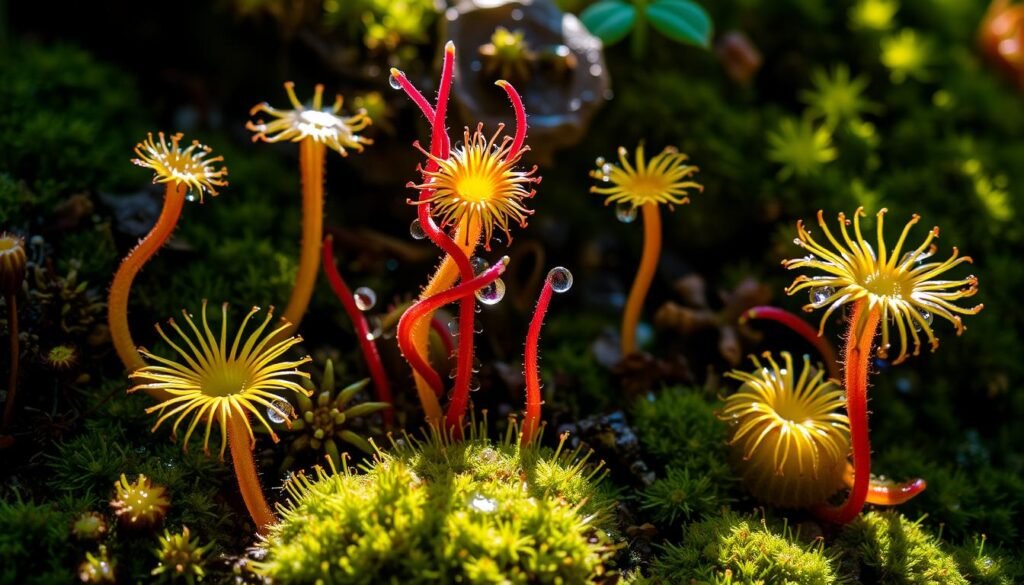
Choosing the Right Sundew Plant for Beginners
Choosing the right sundew species is key for beginners. Some sundews are easy to grow and can handle novice care. Here’s a look at some beginner-friendly plants and their features.
Recommended Beginner Species
- Drosera capensis: This plant is tough and can handle different conditions. It grows to about 8-10 inches tall.
- Drosera spatulata: Known for its beauty and hardiness, it’s another great choice for beginners.
You can find these plants at places like Walmart or local nurseries. Online stores like eBay and FlytrapStore also have them.
Characteristics of Popular Sundews
Knowing what each plant looks like helps you pick the best one for your space.
| Species | Height | Dew Production | Care Requirements |
|---|---|---|---|
| Drosera capensis | 8-10 inches | High | High humidity, acidic soil |
| Drosera spatulata | 6-8 inches | Moderate | Easy care, thrives in milder conditions |
Drosera capensis and Drosera spatulata have beautiful flowers. They last weeks and are white or pale pink. Their dew production is also impressive.
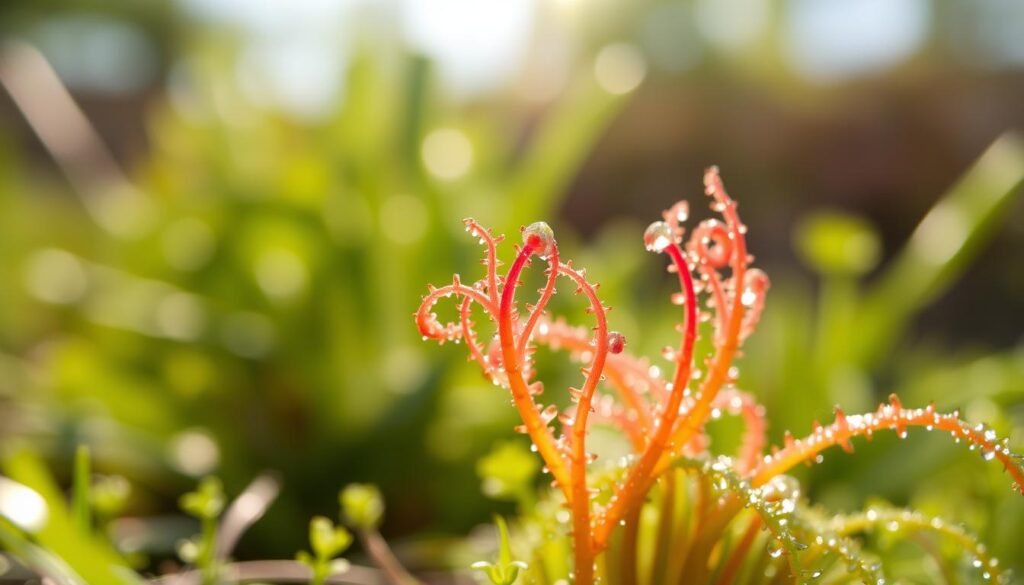
When picking plants, remember that popular sundews are not only beautiful but also easy to care for. Knowing their needs, like a mix of 50% peat and 50% perlite, helps a lot. For more on hydroponic plant care, see this guide.
Understanding the Growing Conditions for Sundew Plants
To grow healthy sundew plants, you need to know their specific needs. These plants do best in certain light, temperature, and humidity levels. By understanding these, you can create the perfect spot for them, whether indoors or outdoors.
Light Requirements
Sundew plants need lots of sunlight to grow well. They should get at least 8 hours of direct sun each day. If you’re growing them indoors, use artificial lights that are at least 40 watts. Place these lights about 12 inches above the plants.
Keep the lights on for 14 hours a day. This helps them grow strong all year round.
Temperature and Humidity Preferences
Sundews love warm weather, never getting colder than 55°F (or 13°C). They usually do well in indoor temperatures. These plants also like their soil to stay moist.
Humidity is key, too. Tropical sundews, for example, thrive in very humid places. To keep the air right, put the pot in a shallow bowl with water. Make sure the soil is moist but not too wet.
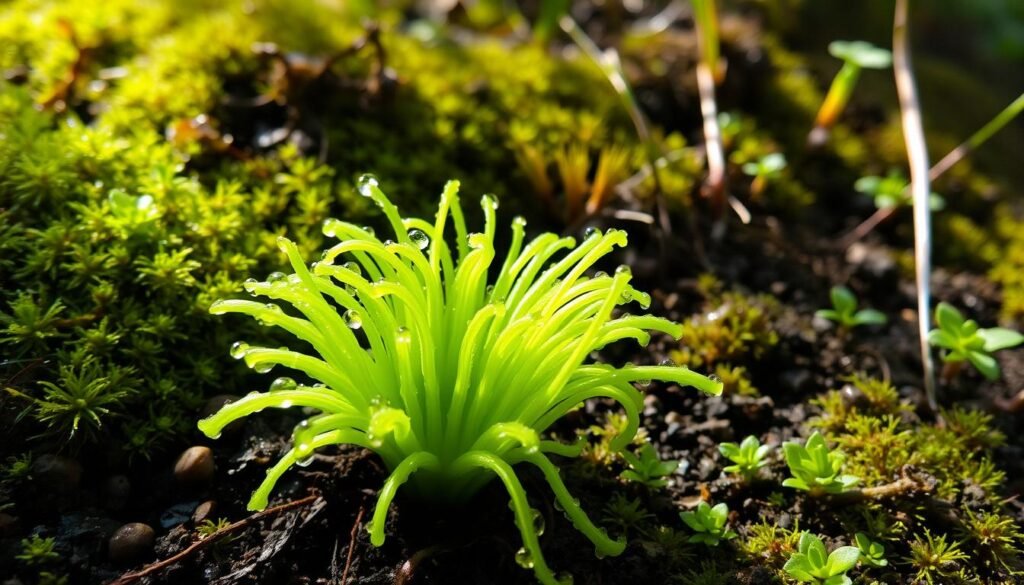
Soil and Potting Mix for Sundew Plants
Choosing the right soil mix is key for sundew plants to grow well. This guide helps you make the perfect potting mix and pick the right containers. A mix that drains well and holds moisture is best for your sundews.
Ideal Soil Composition
A good soil mix for sundews includes peat moss, long-fibered sphagnum moss, and silica sand. Here’s what you need:
- Peat Moss: It’s good because it has less nitrogen. You can find it at Lowe’s, Home Depot, or local garden stores.
- Long-Fibered Sphagnum Moss: It’s a great substitute for peat moss. Make sure to rinse it well to remove algae and mold.
- Silica Sand: It helps the soil drain well. Rinse the sand to get rid of salt and minerals.
For the best results, mix peat moss and silica sand in a 1:1 ratio. Or, try a 5:1 mix of long-fibered sphagnum moss to silica sand. You might need to try different mixes to find what works best for you.
Container Recommendations
Choosing the right container is important for your sundew plants. Use plastic or glazed pots to avoid mineral release from clay pots. The best container should:
- Provide good aeration for the roots
- Have proper drainage to prevent rot
- Give enough space for the roots to grow
Make sure to pack the soil mix loosely at the top of the pot. This helps with moisture and oxygen for the roots. Before planting, rinse the pot and soil to remove harmful substances.
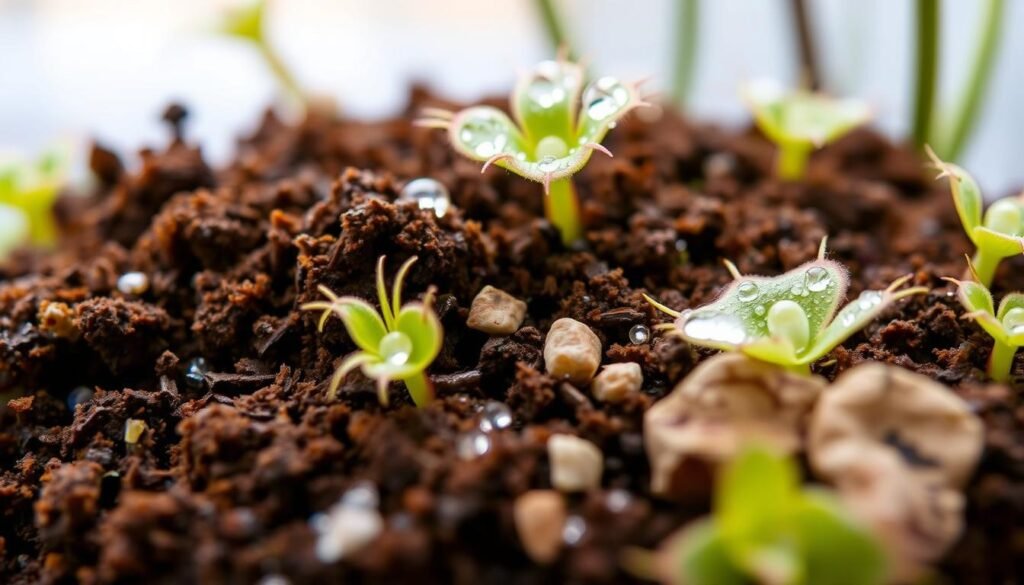
In summary, the right soil mix and container are essential for your sundew plants to thrive. For more tips on growing plants, check out this resource.
Watering Sundew Plants: Best Practices
Watering your Sundew plants right is key to their health. Adjusting your watering based on the environment and plant growth is important. Knowing the best water types and how to use them helps keep the right moisture.
Types of Water to Use
Choosing the right water is critical for Sundews. Distilled or rainwater is best because tap water can harm them. Using quality water helps your plants grow well. For more tips, see this resource on watering.
Watering Techniques for Optimal Moisture
Keeping the right moisture level is all about the watering method. Water every 2 to 4 days, depending on the weather. Water more in summer and less in fall and winter. Bottom-watering helps roots grow deep and avoids leaf rot.
It’s important to check the soil moisture. Use a soil moisture meter or the finger test to know when to water. These tools prevent over- or under-watering. Self-watering pots can also help keep moisture steady.
| Watering Issue | Symptoms | Potential Solutions |
|---|---|---|
| Over-watering | Yellowing leaves, root rot, mold growth | Reduce frequency, improve drainage |
| Under-watering | Wilting leaves, dry soil, leaf curl | Increase frequency, monitor closely |
With the right watering, your Sundew plants will flourish. Regular use of tools and good practices ensure they get enough moisture. This leads to a successful gardening experience.
Feeding Your Sundew Plant
Feeding your sundew plant is key for its growth and health. These plants catch food with sticky leaves, but extra feeding helps too. Adding small insects to their diet can boost growth and flowers.
Knowing when and how to add nutrients is important. This can make your sundews healthier and more vibrant.
Natural Prey and Supplemental Feeding
Sundew plants have different needs. Some need constant food to grow, while others are fine once they’re big. Feeding them every 1-2 months indoors is good for their health.
Using small insects or plant foods can give them the nutrients they need. Start with small amounts to avoid burning their leaves. As they grow, you can give them more food.
Feeding Dos and Don’ts
Knowing what to do and not to do when feeding sundews is important. Don’t use meat or steak, as they’re not good for them. Too much Miracle-Gro or fertilizer can also harm them.
When feeding, put the food in the right spot for them to digest. Place betta pellets in the middle of the leaves. Watch as the leaves curl around the food in 10 to 30 minutes.
If food is left after 3 days, remove it to prevent rot. For more tips on feeding, check this guide on feeding carnivorous plants.
By following these feeding tips, you can keep your sundews healthy and thriving.
Propagation Techniques for Sundew Plants
Starting a sundew collection can be very rewarding. You can use different ways to grow more plants. This guide will show you how to do leaf cuttings, root sections, seed collection, and germination. Learning these methods will help you grow healthy and colorful sundews.
Leaf Cuttings and Root Sections
Leaf cuttings are a popular way to grow sundews. Here’s what you need to do:
- Get your tools ready: scissors, distilled water, a sundew plant, a pot, a lighter, and a small container.
- Pick a healthy leaf and cut it into pieces. Each piece can grow into several new plants.
- Put the cuttings in water or soil, making sure they get enough light.
- Watch the cuttings closely; they might grow in two weeks or two months.
- When you see small green tendrils, it’s time to put the new plants in their own pots.
- Keep the soil moist or cover the pots to keep the air humid.
Root sections are another fast way to get adult plants. They work well for thick-rooted sundews like D. adelae and D. falconeri. Root cuttings grow faster than leaf cuttings.
Seed Collection and Germination
Germinating sundew seeds is exciting. It brings new plants and variety to your collection. Here’s how to collect and care for seeds:
- Get seeds from mature flowers after they dry.
- Sundew seeds can last up to ten years in the fridge. This makes planning easy.
- Seeds help identify unknown sundew plants, adding to your collection.
Some sundews germinate in four months, but tuberous ones might take five years. The right conditions are key for successful germination.
Exploring propagation techniques is rewarding and educational. By using leaf cuttings, root sections, and managing seed germination, you’ll grow your sundew collection successfully.
| Technique | Time to Grow | Expected Results |
|---|---|---|
| Leaf Cuttings | 2 weeks to 2 months | Multiple plantlets from each cutting |
| Root Sections | Faster establishment | Adult plants quickly |
| Seed Germination | 4 months to 5 years | Variety of new plants |
Common Issues When Growing Sundew Plants
Growing sundew plants can be rewarding, but problems may arise. Knowing these issues helps you care for your plants better. Here are some common problems sundew growers face.
Pests and Diseases
Pests like aphids and mealybugs can harm sundew plants. They suck the sap, causing sticky residue and fungal diseases. Regular checks for these pests are key. Environmental factors, like humidity, can also lead to diseases like mold.
Proper care can prevent these issues. For more tips, visit this helpful resource.
Signs of Stress or Poor Care
It’s important to recognize stress signs in sundew plants. Look for discolored leaves or a lack of dew. These signs often mean the plant is stressed or not getting the right care.
Creating the right conditions is key. Make sure your plants have the right soil and temperature. This helps them grow strong and healthy.
| Common Issues | Signs | Solutions |
|---|---|---|
| Pests (Aphids, Mealybugs) | Sticky residue, visible bugs | Use insecticidal soap or neem oil |
| Diseases (Mold) | Visible mold, leaf discoloration | Adjust humidity levels, improve air circulation |
| Stress from Environment | Discolored leaves, lack of dew | Ensure optimal temperature and humidity |
| Improper Soil | Poor growth, dehydration | Repot in suitable soil mixture |
Knowing these common issues helps you care for your sundew plants better. Regular checks and maintenance lead to healthier plants.
Conclusion
Starting a sundew plant journey is exciting, rewarding for all gardeners. This guide has shared key tips for sundew care. You now know how to meet their light, temperature, and humidity needs. Proper watering and feeding will help these plants thrive in your space.
Exploring sundews reveals their beauty and complex needs. Your ongoing effort is vital for mastering sundew care. For more insights, check out Carnivory.eu.
Growing sundews adds to the ecological balance of gardening. Their beauty inspires as they interact with their environment. Enjoy the challenge of growing sundews and watch them thrive in your care.

